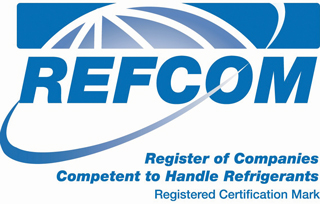AIR CONDITIONING TERMS EXPLAINED
.jpg) As with any other area in life, the air conditioning world has it's fair share of jargon and technical terms. Below we've tried to provide clear explanations of the different types of system available and a brief glossary of technical terms.
As with any other area in life, the air conditioning world has it's fair share of jargon and technical terms. Below we've tried to provide clear explanations of the different types of system available and a brief glossary of technical terms.
If you need any more help please contact us by clicking here, we are always happy to help.
AIR CONDITIONING
Control of air quality – strictly speaking this means temperature, humidity and cleanliness, but commonly used to refer to standard systems that control temperature and provide air filtration but do not control relative humidity.
AIR SOURCE HEAT PUMPS
An air source heat pump is a type of heat pump that uses the outside air as a heat source or heat sink to heat or cool an interior space.
BELOW CEILING UNIT
see Under Ceiling Unit
BTU
British Thermal Unit, a measure of heat energy. It is the amount of energy needed to raise the temperature of one pound of water by one degree Fahrenheit.
1kW = 3412 BTU/hr
COMPRESSOR
The heart of an air conditioning system, used to compress and pump refrigerant around the pipe work circuit. The compressor is generally housed in the outdoor unit.
CONDENSATE
Water condensation is formed with an indoor unit as a natural by-product of the cooling process. This water is collected in a tray and is piped away to drain. Often it is not possible to provide a gravity drain and so a special pump is fitted to remove the water to a suitable waste point or outside.
CONDENSER
Generally a finned coil (like a car radiator) housed in the outdoor unit through which refrigerant is pumped. Outside air is blown through the coil by the condenser fan which picks up heat from the refrigerant and causes the refrigerant gas to condense into liquid.
CASSETTE
An indoor unit that recesses into a false ceiling leaving only a flush mounted grille on view. Room air is drawn up through the central core and is discharged through 4 edge slots, serving an area up to 64m&Mac183;. Excellent air distribution makes them suitable for open plan areas such as large offices and shops and a good alternative to a fully ducted system. Good for refurbishment contracts as they can be installed very quickly with minimal disruption to existing ceilings.
CLOSE CONTROL
Type of system required for commercial application or process where temperature and/or humidity and filtration have to be controlled within specific limits. Clean Room applications usually require close control.
COMFORT COOLING
Provision of cooling only with reasonable temperature control as offered using basic standard equipment to achieve comfortable conditions for occupants. Often referred to as ‘cooling only’.
CONDENSING UNIT
Often referred to as the ‘outdoor unit’, the term for the external unit comprising the compressor, condenser, fan and controls contained within a weather-proof metal housing. Can be sited on the ground or on the roof; units up to 13kW approx. can be mounted on wall brackets. Some units can be sited inside with ducted outside air in and out.
CONTROLLER
Used to control the functions of the air conditioning system, such as ON/OFF, temperature, fan speed, time clock etc. Can be either wired directly to an indoor unit and fixed to the wall or a hand-held infra-red ‘zapper’.
DEHUMIDIFICATION
The process of removing moisture from the air. This is usually a beneficial by product of using an air conditioning system to cool the air as the reduction in room humidity helps achieve comfortable conditions. Can lead to the room becoming too dry in certain conditions.
DUCTWORK
Preformed galvanized steel, either circular (referred to as spiral) or rectangular through which air is distributed. Usually installed above false ceilings and connected to ceiling grilles.
ENHANCED CAPITAL ALLOWANCES (ECA)
A government backed method of encouraging businesses to invest in energy efficient equipment by allowing 100% tax relief in the first year. Qualifying technologies are listed on the Energy Technology List or ETL. Many modern air conditioning systems qualify – to check visit www.eca.gov.uk/etl
EVAPORATOR
Generally a finned coil (like a car radiator) housed in the indoor unit through which refrigerant is pumped. Room air is blown through the coil by the evaporator fan. Heat from the room air is absorbed by the refrigerant and causes the refrigerant liquid to evaporate into a gas. Having given up heat to the refrigerant the air is returned to the room 10-15ºC cooler.
FLEXI UNI
Term used to describe an indoor unit that can be mounted either at low level on the wall (as with a storage heater) or can be turned 90º and mounted on the ceiling adjacent to a wall.
GROUND SOURCE HEAT PUMPS
A ground source heat pump or geothermal heat pump system is a central heating and/or air conditioning system that actively pumps heat to or from the shallow ground. It uses the earth as either a source of heat in the winter, or as a coolant in the summer.
HEAT EXCHANGER
An item of equipment that transfers heat from one fluid to another without allowing them to mix (in this context air is a fluid). In an air conditioning system both the condenser and the evaporator are heat exchangers.
HEAT PUMP
The term for an air conditioning system that can provide heating as well as cooling by reversing the flow of refrigerant. This changes the outdoor heat exchanger into an evaporator and the indoor heat exchanger into a condenser. Even in winter temperatures this system is able to absorb heat from the outdoor air and transfer it, via the refrigeration process, into useful heat indoors. Heat pumps offer a very efficient source of heat – approximately 3kW for every 1kW electricity consumed - and cost only 10-15% more than ‘cooling only’ equipment, so it is not surprising that most systems installed in the UK are heat pump type.
HEATING AND VENTILATION CONTRACTORS ASSOCIATION (HVCA)
Professional body for companies involved in the heating and air conditioning industries. Members are independently inspected an assessed to verify technical competence and commercial capability. Please visit www.hvca.org.uk
HIGH WALL UNIT
All manufacturers have a range of high wall units with capacities from 2 kW to 10 kW, generally suitable for smaller rooms, as the air distribution is limited.
HUMIDITY
The moisture or water vapour in the air. Air can support different amounts of water vapour depending on the temperature (more when warmer). The level is usually expressed as a percentage of the total amount that could be supported at a particular temperature and is termed relative humidity or rh. For comfort, humidity levels should be within the range 30-70% rh.
KILOWATT (KW)
Measure of energy flow used to express the cooling capacity, heating capacity and power consumption of an air conditioning system.
MOBILE (PORTABLE) AIR CONDITIONER
Relatively small self-contained unit usually mounted on castors, that can provide cooling for a small room or office. Often hired as a temporary measure, the unit would discharge heat either via an exhaust hose or a condenser box placed outside through an open window or door. These are often a useful short-term solution during the Summer months.
PACKAGED UNIT
Term for equipment that is not ‘split’. Can be roof mounted with ductwork to inside, or mounted in a roof-space or ceiling void with ductwork to inside and outside. Smaller units, called ‘window’ or ‘through wall’ units can be mounted in the room to be served with the bulk of the unit outside via an opening through the structure (as seen in motels in the US).
REFRIGERANT
The fluid, which flows through the sealed system in the air conditioning pipes, changing state from gas to liquid and back again. The properties of the refrigerants used are that they will evaporate and so absorb heat at typical indoor temperatures and will condense and so give up heat at typical outdoor temperatures.
SPLIT SYSTEM AIR CONDITIONING
Most systems installed are of this type, where the refrigerant system is ‘split’ with the evaporator section inside the building and the condensing unit outside the building. The two units are connected with copper pipe work and control cabling and, depending on the size and manufacturer, can be up to 70m apart. The indoor units can be floor, wall, and ceiling or above ceiling mounted and the outdoor units can be sited on the ground, on wall brackets or on a roof so these systems are very flexible and can be installed in just about any application.
THERMOSTAT
A temperature operated switch that turns the compressor on and off.
UNDER CEILING UNIT
An indoor unit that is used where there is no false ceiling available (for a cassette) and where wall units are not suitable or desirable. Provides a fan shaped air distribution in one direction which is better than using a wall unit but not as effective as a cassette. Not suitable for small rooms.
VRV AIR CONDITIONING - VARIABLE REFRIGERANT VOLUME (VRV)
Larger systems operate using this method to vary the amount of refrigerant volume flowing through the system in line with the cooling required and offer advantages of efficiency and equipment size against traditional central systems such as chilled water or ducted air systems. Also referred to as Variable Refrigerant Flow (VRF) systems can comprise of several hundred indoor units connected to one control panel and are suitable for office suites, large retail premises, hotels etc. Exceptional energy efficiency can be achieved by using the heat recovery version which can simultaneously provide cooling and heating by using some indoor units as evaporators and others as condensers, thereby reducing compressor usage.
Find out more







